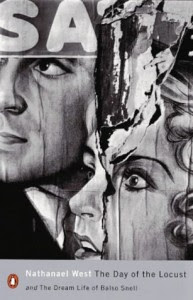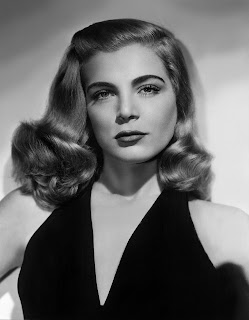
"Linda Darnell works as a waitress at the local restaurant run by Pop, played by Percy Kilbride, who would in the fifties click big opposite Marjorie Main in the successful Ma and Pa Kettle series from Universal. Pop has a crush on the younger woman as does another regular patron, a former New York City police detective played by Charles Bickford, who has come to California allegedly to improve his health. Meanwhile Darnell is also seen dating traveling salesman Bruce Cabot.

Andrews experiences Darnell’s toughness in his first visit to Pop’s restaurant. The gentle and accommodating Kilbride tells new man in town that he does not have to pay for his coffee. Darnell tartly demurs, telling her boss that he had provided a coffee for the town’s new visitor and that he should have to pay for it.
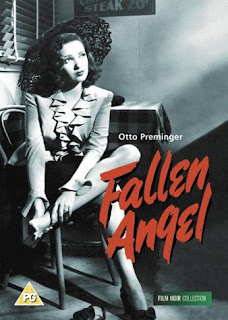
Far from being repulsed by Darnell’s toughness, Andrews is instead instantly smitten. He feels a camaraderie. She is, like him, someone from the wrong side of the tracks and he can relate to her, which means that Darnell has picked up one more male admirer in Walton, and this one is determined to proceed to great length to win her over.

Tough girl Darnell, after telling Andrews about her impoverished youth in San Diego, delivers an ultimatum. She wants marriage to a man of means, not a drifter who will move her from town to town. Andrews will either obtain sufficient funds to keep her in style or she will have nothing to do with him. She had earlier coldly abandoned Bruce Cabot for not measuring up to her expectations.

Faye fits into the classic definition of the strong supporting woman of film noir, but what about Darnell? Can she be classified as a femme fatale? She is definitely tough, uncompromising, and selfish. Darnell feels no compassion for Faye after learning that Andrews’ game plan revolves around a brief sham marriage to grab her money.
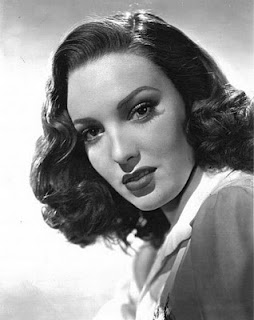
If Darnell is a femme fatale then it is one without the noticeable deadly sociopath’s demeanor of classic noir leading ladies Barbara Stanwyck in “Double Indemnity” and Jane Greer in “Out of the Past”. Murder is an intrinsic part of doing business to Stanwyck and Greer. Tough Darnell could therefore be called a femme fatale with qualification. She is a femme fatale of sorts".
Source: www.noiroftheweek.comLinda Darnell in one of her best performances ("Fallen Angel" in 1945).

"In 1945, a year after the tremendous success of Laura, director Otto Preminger again uses Dana Andrews, this time as as a drifter, Eric Stanton , who is thrown off a San Francisco bus for limited funds to continue.

A survivor, with use of his charm and well dressed demeanor, falls almost immediately for a waitress named Stella (Linda Darnell), who half the town appears to be nursing a huge crush on. Even though she only shows her mean-spirited side.
Film clips: Des films noirs et des autres genres de films, les femmes fatales avec les yeux des anges. Clip with scenes starred by femme fatales with angel eyes. Song: "Angel Eyes" music by Matt Dennis, lyrics by Earl Brent. Performed by Bruce Springsteen.
Marie Windsor in THE NARROW MARGIN (1952)
Cleo Moore in ON DANGEROUS GROUND (1951)
Claire Trevor in BORN TO KILL (1947)
Veronica Lake in THIS GUN FOR HIRE (1942)
Ella Raines in PHANTOM LADY (1944)
Louise Brooks in PANDORA'S BOX (1928)
Jean Gillie in DECOY (1946)
Jane Russell in HIS KIND OF WOMAN (1952)
Anne Baxter in THE BLUE GARDENIA (1953)
Lauren Bacall in THE BIG SLEEP (1946)
Jane Greer in OUT OF THE PAST (1947)
Rita Hayworth in THE LADY FROM SHANGHAI (1948)
Bibi Andersson and Liv Ullmann in PERSONA (1966)
Lana Turner in THE POSTMAN ALWAYS RINGS TWICE (1946)
Simone Simon in CAT PEOPLE (1942)
Clara Bow in MY LADY OF WHIMS (1925)
Ingrid Bergman in ARCH OF TRIUMPH (1948)
Monica Vitti in L'ECLISSE (1962)
Marie Windsor in THE NARROW MARGIN (1952)
Anna May Wong in PICCADILLY (1929)
Ella Raines in PHANTOM LADY (1944)
Gloria Grahame in THE BIG HEAT (1953)
Ava Gardner in THE KILLERS (1946)
Lizabeth Scott in DEAD RECKONING (1947)
Hedy Lamarr in ALGIERS (1938)
Ella Raines in PHANTOM LADY (1944)
Gene Tierney in LAURA (1944)
Joan Crawford in MILDRED PIERCE (1945)
Dorothy Dandridge in ISLAND IN THE SUN (1957)
Constance Dowling in BLACK ANGEL (1946)
Mary Meade in T-MEN (1947)
Rita Hayworth in GILDA (1946)
Peggy Cummins in GUN CRAZY (1950)
Lizabeth Scott in DEAD RECKONING (1947)
Fay Helm in PHANTOM LADY (1944)
Louise Brooks in PANDORA'S BOX (1928)
Marlene Dietrich in SHANGHAI EXPRESS (1932)

Jane Greer and Lizabeth Scott in "The company she keeps" (1951)
"John Cromwell went on to direct the important noirs, The Racket (1951), Caged (1950), and The Company She Keeps (1951), but he had no track record in noir in 1946, and the team of writers behind the screenplay doesn’t amount to the usual suspects to any degree – but for one exception. The script was adapted from a story by Sidney Biddell and Gerald Adams. Adams went on to script The Big Steal (1949) and Armored Car Robbery (1950), and wrote the story for His Kind of Woman (1951 uncredited). Allen Rivkin who wrote the film treatment, later scripted Gambling House (1950) and Tension (1949). The screenplay was a joint effort of Oliver H.P. Garrett and Steve Fisher. Garrett has no other noir credits, so the perp has to be Fisher who had form. Fisher wrote the stories for I Wake Up Screaming (1941) and Johnny Angel (1945), and scripted Berlin Correspondent (1942) and Lady in the Lake (1947).

Lizabeth Scott and Humphrey Bogart in "Dead Reckoning" (1947)
The intrepid Bogie in mufti tracks down the girlfriend, Scott, an ex-chanteuse in a casino fronting as a cabaret, who after reprising her recent chart-hit and making an impression, introduces Bogie to the casino-operator, a suave foreigner engagingly played by Morris Carnovsky, and his sadistic henchman (a great camp turn by Marvin Miller). Well one drink leads to another – the last one spiked – and Bogie wakes up with a heavy hangover in his hotel-room and a stiff in the other twin-bed for company. You get the picture? Then all proceeds apace as Bogie endeavors to find out who killed his buddy and why. There is a double and later a triple-cross, with Bogie falling hard for Scott. The femme-fatale smells of jasmine not honey-suckle, and she just happens to be the casino guy’s wife! The final shoot-out is Out of the Past out of The Big Sleep.
Source: filmsnoir.net
Lizabeth Scott in Too Late for Tears (1949) directed by John Cromwell
Lizabeth Scott plays Ivy Hotchkiss in "You came along" (1945) directed by John Farrow

Lizabeth Scott and Dick Powell in Pitfall (1948) by André De Toth
"Pitfall" now ranks as classic noir: French filmmaker Bertrand Tavernier considers it one of the genre's masterpieces.
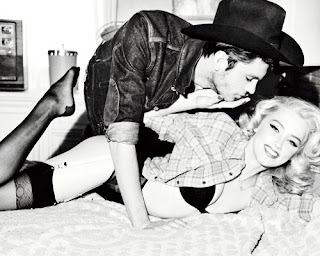











 Showing off her posing prowess, Amber Heard is looking hot in the new Guess Jeans Fall 2011 photo shoot. The “Joneses” babe takes a retro-chic turn in the black-and-white images, making a cute cowboy very happy in the process. Source: www.celebrity-gossip-net
Showing off her posing prowess, Amber Heard is looking hot in the new Guess Jeans Fall 2011 photo shoot. The “Joneses” babe takes a retro-chic turn in the black-and-white images, making a cute cowboy very happy in the process. Source: www.celebrity-gossip-net









 Marilyn Monroe in her promotional stills of "Bus Stop" (1956) directed by Joshua Logan
Marilyn Monroe in her promotional stills of "Bus Stop" (1956) directed by Joshua Logan






















